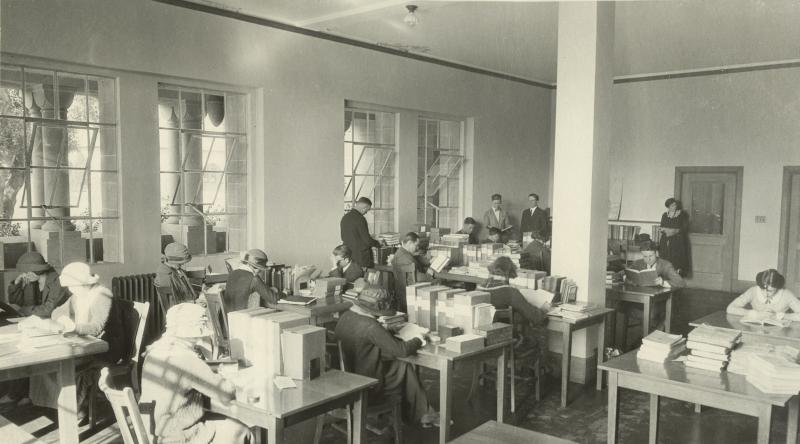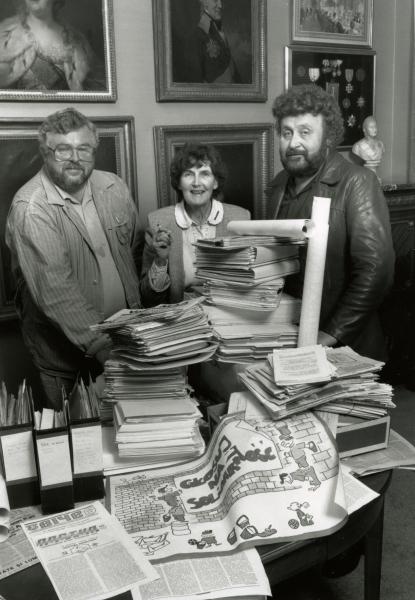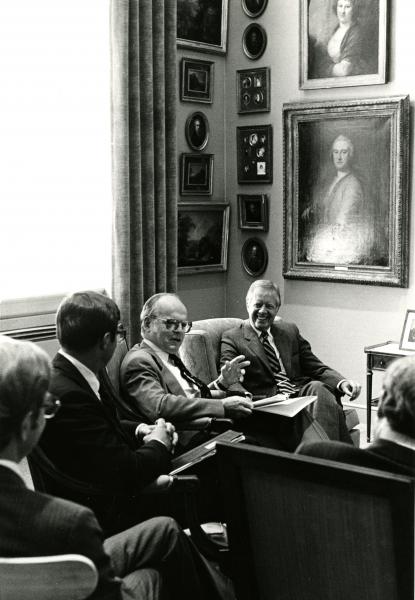The Hoover Library and Archives at 100: Worlds In A Tower
Originally published in the October 2019 NewsNet. To view footnotes, please see the October 2019 NewsNet.
The Hoover Library and Archives at 100: Worlds In A Tower
Eric T. Wakin, Hoover Institution Library & Archives
Established by future president Herbert Hoover at his alma mater, Stanford University, the Hoover Institution marks its centennial in 2019. What began as the Hoover War Library with a $50,000 donation by its namesake, and the founding goal to “collect historical material on war,” has now grown into the Hoover Institution on War, Revolution, and Peace. The Hoover Tower and carillon (dedicated in 1941) dominate the ever-expanding Hoover campus, itself located at the heart of Stanford University in Palo Alto, California.
The Institution’s two pillars are its fellows and its Library & Archives. Hoover fellows are an interdisciplinary group of humanists, social and political scientists, and natural scientists, who study economics, education, energy, foreign affairs, health care, national security and politics, history, law, and information technology. Our fellows have both academic and practical experience, whether at Stanford or other top universities, and often with service at the highest levels of government or the private sector. The soon to be opened George P. Shultz building is named after the Hoover Institution’s Thomas W. and Susan B. Ford Distinguished Fellow, one of only two people to have held four cabinet-level appointments, including Secretary of State and Treasury.
Hoover’s Library & Archives is committed to collecting, preserving, providing access to, and supporting engagement with the most vital material related to global political, social, and economic change. Our collections relating to Europe, Russia and the Soviet Union, Asia, the Middle East, Latin America and Africa are among the largest in the world. It has a focused collecting program, closely aligned with our institutional mission, and includes digital access initiatives, exhibitions, research, fellowship programs, academic events, and teaching. The Library & Archives continue Mr. Hoover’s vision that the Institution “must not be a mere library” but that it support a vibrant international community of scholars and a broader public interested in the meaning and role of history.
The Hoover Library and Archives have long occupied a critical position in a national, international, and regional network of archives and libraries. In the early years after its founding, great Hoover collectors such as Ralph Lutz, the A.R.A. representative, and historian Frank A. Golder, and others focused particularly on print, archival and visual ephemera of Germanic and Russian-Soviet provenance.

In the interwar and post-War periods collecting emphases expanded to include Asia, Africa, the Middle East and Latin America. Without the efforts of these founding curators and their modern successors, some of the “destination” collections in the Hoover Archives and Library may well have perished in their countries of origin.
 By the beginning of the Twenty-first century, further re-alignments and cooperative agreements with Stanford University’s Libraries strove to reduce duplication in building print collections, thereby allowing Hoover curators to give even greater attention to acquiring original archival, visual and non-print media resources.
By the beginning of the Twenty-first century, further re-alignments and cooperative agreements with Stanford University’s Libraries strove to reduce duplication in building print collections, thereby allowing Hoover curators to give even greater attention to acquiring original archival, visual and non-print media resources.
In recent years, curatorial staff have also begun to reassess, catalog, exhibit and digitize, in some cases for the first time, many important parts of the collections, including precious collections of illustrated travel books of the 17-19th centuries, special association and provenance books, and some of the paintings and objets held in Hoover’s repositories and exhibit areas.
Today the collections of the Library & Archives continue to grow under the stewardship of scholar-curators who supervise holdings that include 750,000 volumes in over 70 languages, almost 7,000 archival collections, and hundreds of art objects and artifacts.
 In a happy coincidence, the 51st National Convention of ASEEES will take place in San Francisco, just a short distance from Hoover and Stanford at the south end of the Bay. As one of its contributions to the Conventions, the Hoover Library and Archives is privileged to sponsor a Round Table and Panel (Sunday November 24, morning and afternoon) offering both “A Glance to the Past” and a look at “Today and the Future.” Some of the presentations and discussions will focus on those individuals who formed the collections, and the ways these collections have been used in the past and today. Those conventioneers who make on-site visits to Stanford are also invited to visit Hoover@100: Ideas Defining A Century, in the Hoover Tower, a showcase of documents and artifacts centered around the ideas of peace, freedom, and education—ideas that are reflected in the lives of Herbert Hoover and his wife, Lou Henry, and that drove the Institution’s collecting and the work of its eminent fellows in its first century of existence. Posters, correspondence, photographs, and manuscripts drawn exclusively from the Hoover Library and Archives’ collections, are among the materials on display. The new exhibition galleries will be open seven days a week, 10 am–4 pm.
In a happy coincidence, the 51st National Convention of ASEEES will take place in San Francisco, just a short distance from Hoover and Stanford at the south end of the Bay. As one of its contributions to the Conventions, the Hoover Library and Archives is privileged to sponsor a Round Table and Panel (Sunday November 24, morning and afternoon) offering both “A Glance to the Past” and a look at “Today and the Future.” Some of the presentations and discussions will focus on those individuals who formed the collections, and the ways these collections have been used in the past and today. Those conventioneers who make on-site visits to Stanford are also invited to visit Hoover@100: Ideas Defining A Century, in the Hoover Tower, a showcase of documents and artifacts centered around the ideas of peace, freedom, and education—ideas that are reflected in the lives of Herbert Hoover and his wife, Lou Henry, and that drove the Institution’s collecting and the work of its eminent fellows in its first century of existence. Posters, correspondence, photographs, and manuscripts drawn exclusively from the Hoover Library and Archives’ collections, are among the materials on display. The new exhibition galleries will be open seven days a week, 10 am–4 pm.
Eric Wakin is the deputy director of the Hoover Institution and the Robert H. Malott Director of the Institution’s library and archives, overseeing their strategic direction and operations.
